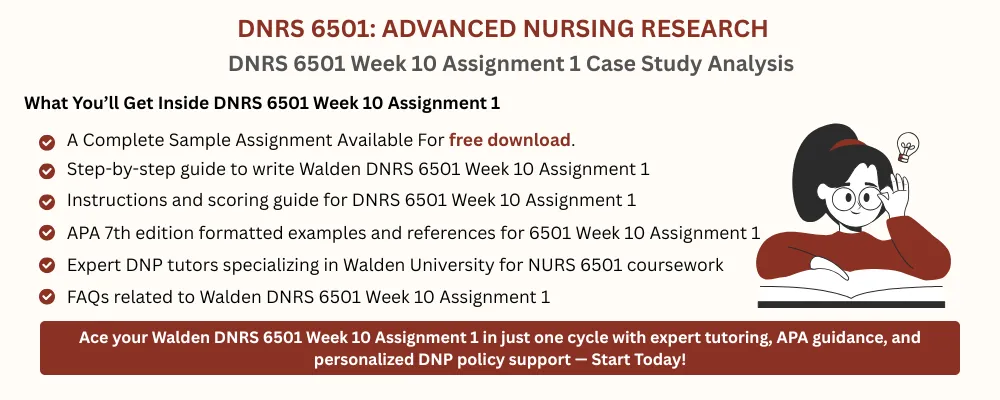DNRS 6501 Week 10 Assignment 1 FREE DOWNLOAD
DNRS 6501 Week 10 Assignment 1
Case Study Analysis
Student name
Walden University
DNRS 6501: Advanced Nursing Research
Professor Name
Date
Case Study Analysis
The study examines a sexually active 21-year-old woman who shows vaginal symptoms along with discharge that began three days ago. A new sexual partner joins her life as she continues using birth control. The Cervical swab PCR examination yielded positive results for Chlamydia trachomatis. The patient received normal results for both urinalysis and pregnancy test examinations.
Pathophysiologic Process of Chlamydia
As an intracellular bacterium, Chlamydia trachomatis has two developmental stages known as the biphasic life cycle. The bacterium exists in two different stages that include the infectious elementary body (EB), which exists outside cells, and the non-infectious reticulate body (RB), which resides within cells. The elementary body of Chlamydia penetrates host epithelial cells by using endocytosis as an entry mechanism. The bacterium transforms into the RB after entering the cell and exploits cellular resources for reproduction (Jury et al., 2023). The RBs undergo several divisions before forming EBs that escape cells to infect neighboring cells.
The intracellular life cycle of Chlamydia makes it possible for the pathogen to avoid detection by the immune system. The inclusion membrane alteration, together with suppressed host apoptotic pathways, protects the bacterial particles from lysosomal destruction. Persistent infection happens because Chlamydia modifies host cell signaling, then downregulates MHC expression and blocks antigen presentation mechanisms (Jury et al., 2023). The immune evasion process leads to sustained infections as well as increases the risk of long-term complications.
Host Immune Response
After infection with chlamydia, the immune system of the host activates both innate and adaptive immune mechanisms. The first response of pattern recognition receptors (PRRs), such as Toll-like receptors (TLRs) on epithelial cells, happens when they detect pathogen-associated molecular patterns (PAMPs) from Chlamydia (Yang et al., 2024). The recognition activates the release of proinflammatory cytokines, including interleukin-1 (IL-1), interleukin-6 (IL-6), and tumor necrosis factor-alpha (TNF-α) that attract neutrophils and macrophages to the infection area.
Dendritic cells extract Chlamydia antigens to show them to T cells, so the adaptive immunity starts. The production of interferon-gamma (IFN-γ) by CD4+ T-helper cells enables macrophage activation, which helps control the infection. The immune response produces tissue damage as one of its secondary effects (Yang et al., 2024). Persistent inflammation, together with immune system damage to epithelial tissue cells, results in fibrosis that causes scarring, particularly in the fallopian tubes, which raises the chances of ectopic pregnancy and infertility.
Risk Factors for STDs
The patient faces increased the chances of getting chlamydia because of multiple risk factors. Young people between 25 years old and younger who engage in sexual activities face the greatest demographic risk for STDs. A new sexual relationship puts individuals at higher risk because they become exposed to partners who have not been treated for STDs (Wang et al., 2023). The case does not explicitly detail that unprotected sexual encounters with numerous partners lead to increased STD risks. Chlamydia shows a tendency to remain asymptomatic, thus enabling it to spread unnoticed throughout sexual networks.
Potential Complications of Chlamydia
Chlamydia trachomatis infection, which remains untreated, creates severe reproductive issues that primarily affect female patients. Pelvic inflammatory disease (PID) represents a major concern since the infection spreads upward to the uterus and the fallopian tubes, and the ovaries. The persistent spread of PID causes tissue scarring, which forms adhesions that harm reproductive organs. The infection leads to tubal factor infertility and raises the possibility of ectopic pregnancy development when an egg becomes implanted outside the uterus. When pregnant women fail to treat chlamydia, it may cause premature labor and premature membrane rupture, and newborn infection (Wang et al., 2023). Infants exposed to Chlamydia at birth may develop pneumonia along with conjunctivitis.
Conclusion
The detection and treatment of Chlamydia trachomatis infections within sexually active young individuals demonstrates significant clinical value. The bacterium successfully circumvents immune system reactions and securely maintains intracellular survival, which renders it a complicated pathogenic agent. The prevention of chlamydia transmission, along with other STDs, depends on routine testing and education for patients and protective sexual behavior.
Struggling with DNRS 6501 Week 8 Assignment Case Study Analysis? Get ready-to-use help and improve your grades today!
Instructions To Write DNRS 6501 Week 10 Assignment 1
Need instructions for this assessment? Contact us now and get expert guidance right away!
Instructions File For 6501 Week 10 Assignment 1
CASE STUDY ANALYSIS
An understanding of the factors surrounding women’s and men’s health can be critically important to disease diagnosis and treatment in these areas. This importance is magnified by the fact that some diseases and disorders manifest differently based on the sex of the patient.
Effective disease analysis often requires an understanding that goes beyond the human systems involved. The impact of patient characteristics, as well as racial and ethnic variables, can also have an important impact.
An understanding of the symptoms of alterations in systems based on these characteristics is a critical step in diagnosis and treatment of many diseases. For APRNs, this understanding can also help educate patients and guide them through their treatment plans.
In this Assignment, you examine a case study and analyze the symptoms presented. You identify the elements that may be factors in the diagnosis, and you explain the implications to patient health.
RESOURCES
Be sure to review the Learning Resources before completing this activity. Click the weekly resources link to access the resources.
WEEKLY RESOURCES
To prepare:
By Day 1 of this week, you will be assigned to a specific case study scenario for this Case Study Assignment. Please see the “Announcements” section of the classroom for your assignment from your Instructor.
The Assignment (1- to 2-page case study analysis)
Develop a 1- to 2-page case study analysis by answering the questions provided following the case scenario.
BY DAY 7 OF WEEK 10
Submit your Case Study Analysis Assignment by Day 7 of Week 10.
Reminder: The College of Nursing requires that all papers submitted include a title page, introduction,
summary, and references. The sample paper provided at the Walden Writing Center provides an
example of those required elements (available at
https://academicguides.waldenu.edu/writingcenter/templates). All papers submitted must use this
formatting.
SUBMISSION INFORMATION
Before submitting your final assignment, you can check your draft for authenticity. To check your draft,
access the Turnitin Drafts from the Start Here area.
To submit your completed assignment, save your Assignment as
WK10Assgn2_LastName_Firstinitial
Then, click on Start Assignment near the top of the page.
Next, click on Upload File and select Submit Assignment for review
DNRS 6501 Week 10 Assignment 1 Rubrics



References For DNRS 6501 Week 10 Assignment 1
Jury, B., Fleming, C., Huston, W. M., & Luu, L. D. W. (2023). Molecular pathogenesis of Chlamydia trachomatis. Frontiers in Cellular and Infection Microbiology, 13, 1281823. https://doi.org/10.3389/fcimb.2023.1281823
Wang, X., Ouyang, Z., Liu, E., & Han, M. (2023). Sexually transmitted infections and associated risk factors among sexual minority women in China. Scientific Reports, 13(1), 21583. https://www.nature.com/articles/s41598-023-48745-7
Yang, S., Zeng, J., Yu, J., Sun, R., Tuo, Y., & Bai, H. (2024). Insights into chlamydia development and host cells response. Microorganisms, 12(7), 1302. https://pmc.ncbi.nlm.nih.gov/articles/PMC11279054/
Best Professors To Choose From For DNUR 6501 Class
- Dr. Linda Johanson
- Dr. Catherine Fant
- Dr. Deborah Terry
- Dr. Christine Frazer
- Dr. Carolyn Sipes
(FAQs) related to DNRS 6501 Week 10 Assignment 1
Question 1: Where can I download a free sample for DNRS 6501 Week 10 Assignment 1?
Answer 1: Download a free sample for DNRS 6501 Week 10 Assignment 1 from Tutors Academy to review its format.
Question 2: Where can I find the rubrics and instruction file for DNRS 6501 Week 10 Assignment 1?
Answer 2: Access the rubrics and instructions for DNRS 6501 Week 10 Assignment 1 at Tutors Academy.
Question 3: What is DNRS 6501 Week 10 Assignment 1 about?
Answer 3: It’s a case study analysis applying advanced nursing research concepts, available at Tutors Academy.
Do you need a tutor to help with this paper for you with in 24 hours.
- 0% Plagiarised
- 0% AI
- Distinguish grades guarantee
- 24 hour delivery

